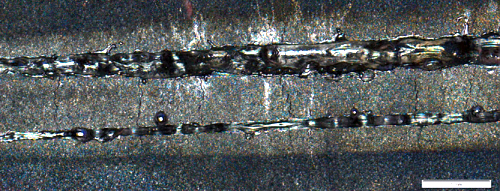
University of California, Santa Cruz (UCSC) Professor of Applied Mathematics Dongwook Lee has won a three-year, $1.1 million grant from the U.S. Department of Energy, which will fund his research on improving computer models for safety mechanisms within particle accelerators.
For this project, Lee will collaborate with scientists at the Advanced Photon Source (APS) at Argonne National Laboratory, the site of one of five of the U.S.’s ultra-bright light source facilities. These sites, called x-ray light source user facilities, produce x-ray beams studied by scientists for a wide range of applications in medicine, biology, material science, astrophysics, and more.
The APS facility at Argonne is donut-shaped, with beams of electrons shot out from a linear particle accelerator in the center. The beams are then bent by magnets to travel in circles in a storage ring at very close to the speed of light. When the electrons bend, they emit synchrotron radiation in the form of very bright x-ray light.
Occasionally, the electron beam is lost in an unplanned manner due to a power supply failure or interlock trip. This is what scientists call a “whole beam dump,” and special components (collimators), which are made of solid metals, are used to prevent the beams from damaging equipment. As the collimators stop the beams, they can be damaged by the generation of high-energy-density conditions (Fig. 1). The ongoing technical upgrade of the APS (the APS Upgrade Project, APS-U) is expected to result in very intense electron beams, which will increase the damage to the collimators as they encounter extreme high-energy-density conditions that impact machine protection.
The crux of this project is to study these processes and ensure the integrity and reliability of the collimators. Lee’s role will primarily be to develop high-fidelity numerical models for the physics of the whole beam dumps with the new APS-U system. In addition to researchers at Argonne, Lee will collaborate with the company RadiaSoft™, whose physicists study accelerator particle physics as well as particle and material interactions.
“Unlike many other typical proposals, this team has very unique expertise in different areas,” Lee said. “This project is a fine example of how applied mathematics can help advance real world problems.”
For the last two years, Lee and members of the APS Accelerator Systems Division have been working on preliminary research into the hydrodynamics of this problem with the support of Laboratory Directed Research and Development seed funding from Argonne. Jeff Dooling (APS Accelerator Systems Division Accelerator Operations Physics Group and first author on the journal article derived from this work) was instrumental in obtaining this funding. The project team includes Lee’s former Ph.D. student, Youngjun Lee, who worked on the initial studies with the seed funding and is now a postdoctoral researcher at Argonne. The funding will also support a new Ph.D. student in the UCSC Applied Mathematics Department.
Lee uses Flash-X, a popular open-source community code for astrophysicists and high-energy-density physics, to develop his computational models. As part of the project, the team will deliver and make publicly available the numerical code for doing this research, making it available to the research community for the continuation of this pioneering work.
“We want to deliver our science with more clarity and more transparency in our effort,” Lee said.
For more information on this collaboration and its work to date, see:
J. Dooling, M. Borland, W. Berg, J. Calvey, G. Decker, L. Emery, K. Harkay, R. Lindberg, G. Navrotksi, V. Sajaev, S. Shoaf, Y. P. Sun, K. P. Wootton, A. Xiao, A. Grannan, and A. H. Lumpkin, “Collimator irradiation studies in the Argonne Advanced Photon Source at energy densities expected in next-generation storage ring light sources,” Phys. Rev. Accel. Beams 25, 043001 (8 April 2022). DOI: 10.1103/PhysRevAccelBeams.25.043001
The Advanced Photon Source is a U.S. Department of Energy Office of Science User Facility operated for the U.S. Department of Energy Office of Science by Argonne National Laboratory under Contract No. DE-AC02-06CH11357
____________________________________________
The U.S. Department of Energy's APS at Argonne National Laboratory is one of the world’s most productive x-ray light source facilities. Each year, the APS provides high-brightness x-ray beams to a diverse community of more than 5,000 researchers in materials science, chemistry, condensed matter physics, the life and environmental sciences, and applied research. Researchers using the APS produce over 2,000 publications each year detailing impactful discoveries, and solve more vital biological protein structures than users of any other x-ray light source research facility. APS x-rays are ideally suited for explorations of materials and biological structures; elemental distribution; chemical, magnetic, electronic states; and a wide range of technologically important engineering systems from batteries to fuel injector sprays, all of which are the foundations of our nation’s economic, technological, and physical well-being.
Argonne National Laboratory seeks solutions to pressing national problems in science and technology. The nation's first national laboratory, Argonne conducts leading-edge basic and applied scientific research in virtually every scientific discipline. Argonne researchers work closely with researchers from hundreds of companies, universities, and federal, state and municipal agencies to help them solve their specific problems, advance America's scientific leadership and prepare the nation for a better future. With employees from more than 60 nations, Argonne is managed by UChicago Argonne, LLC, for the U.S. DOE Office of Science.
The U.S. Department of Energy's Office of Science is the single largest supporter of basic research in the physical sciences in the United States and is working to address some of the most pressing challenges of our time. For more information, visit the Office of Science website.
